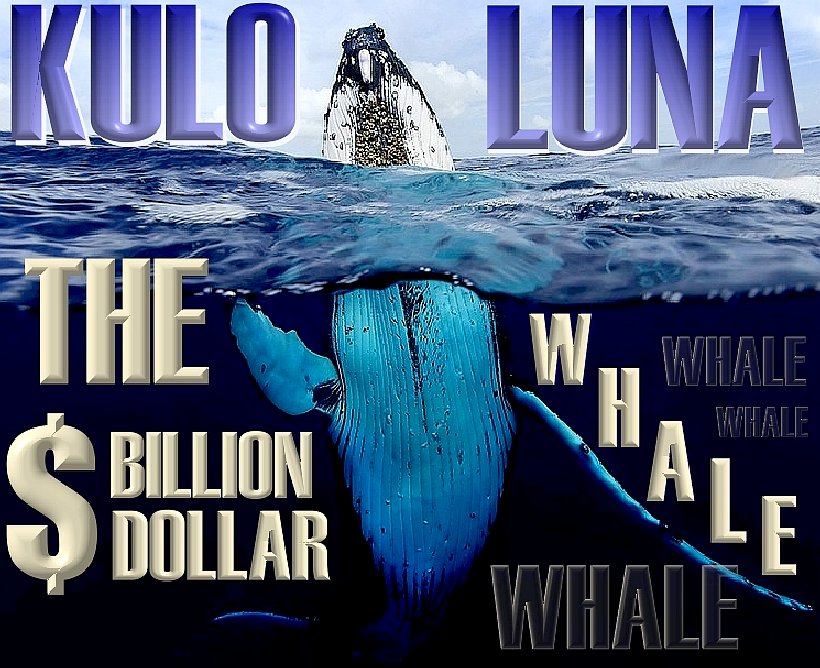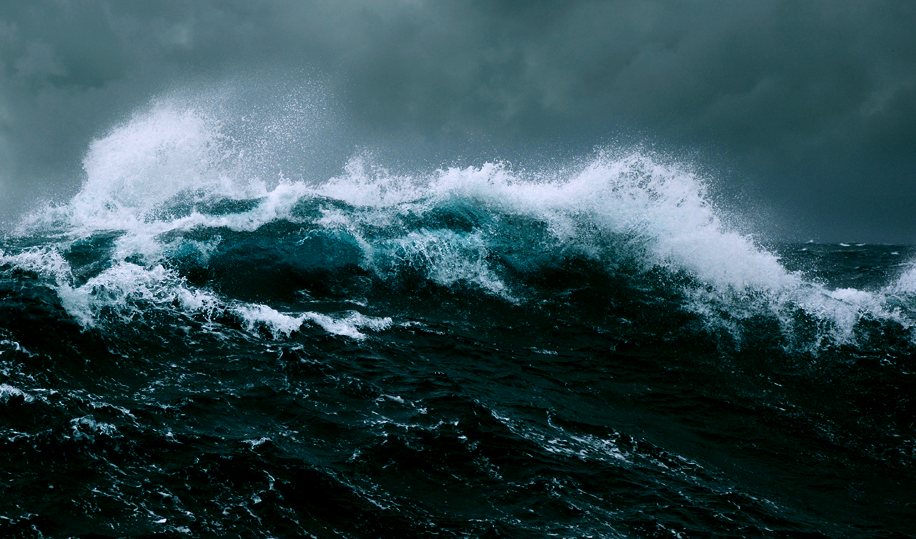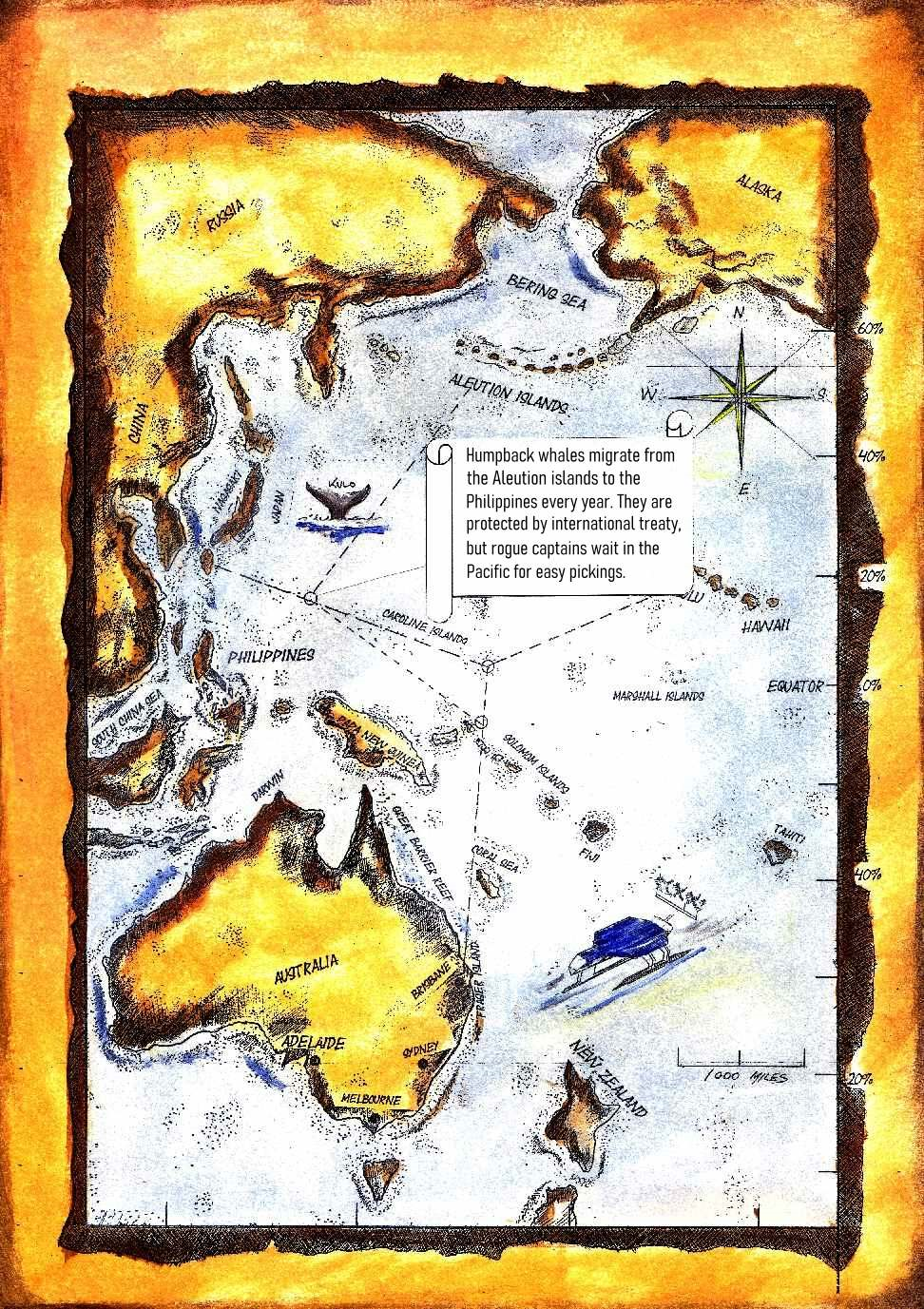
The
adventures of John Storm and the Elizabeth Swann. John Storm is an ocean
adventurer and conservationist. The Elizabeth Swann is a fast solar
powered boat. During a race around the world, news of the sinking of a
pirate whaling ship reaches John Storm and his mate Dan Hawk. They
decide to abandon the race and try and save the whale.
(Original
Book Chapter 34) – The Coral Sea - 150 S,
1570 E
STORM
CLOUDS <<<
Fuelled by heavy clouds and gusty 80 mph winds, the sea spray stung John as he clambered across the walkway between pods. Using a bright hand-held searchlight he looked for whatever damage had caused that squeal of metal. John recalled that in 1770 Captain James Cook, the famous British cartographer had run his ship the Endeavour aground on an uncharted reef in these same waters south of the Solomon Islands, after which the almost obsessive map maker made it his mission to chart channels through the maze of living reefs. Cook's ship was far beefier at 368 tons with a deep draught, so John reckoned the
'Swann' would be safe, not being so deep in the water, but then he had flooded the ballast tanks precisely to lower the boat in the water, and that sound came from somewhere.
Coral
can cause serious damage to a hull. the living coral animal is soft enough, consisting of a cylinder called a polyp with a mouth at one end surrounded by tentacles, the other end attached to a solid seafloor surface, similar to an anemone. But when they die, they leave behind a hard limestone skeleton of calcium carbonate that can tear a hull to shreds. They are colonial animals that reproduce by budding, which builds on the hard skeletons of old polyps to form the great bulbous fans synonymous with a healthy reef. As they grow they reach out from the sea floor to the surface, which is where they can become a navigation obstacle.
John inched closer to the rear pod, shining his light on the underside of the
solar panel array, up and down, left and right. He could see no damage there. So he pushed on into and through the accommodation bunk area to the rear helm feeling less confident that all would be well. His movements were slightly restricted by the storm proof oilskins he was wearing. Though made of modern lightweight materials with layers to allow the skin to breathe but not let water in, the suit still took some getting used to.
John cast the torch along the shiny alloy beam that went aft out to sea from the pod by eight meters, in a process of elimination that
Sherlock Homes would have approved. It all looked fine until he played the light to port and then to starboard along the
uprights that supported the turbine generator aloft. Then he saw that
one of the four frame sections had become twisted where a control rod
half way up the mast had snapped.
That being the case, the structural
integrity was much reduced and would put a strain on the other three
sections. All of the control rods worked together to keep the two
parallel mast ladder-sections straight, working together as a moveable space-frame and the wind turbine aligned correctly into the
wind, rather than at an angle so that safe speed could not be
calculated. It was fortunate indeed that John had braked and parked the
assembly to brace for the storm, or by now the mast would be sushi, and
the turbine blades buckled.
John radioed "Dan, we've got a problem with the turbine's mast, I'm going aloft to check that the wings are okay. Over".
Roger that skip. How bad is it. Can't it wait? Over."
"No time like the present, but, yes, we'll let the storm die down before getting serious. I've just got to see what downtime we're facing. I just hope that whatever we're having to deal with, the pirates are having problems also. Out"
John climbed the ladder to the deck and immediately saw that the port wing forward had caught it. At least three panels were cracked and another was bent backwards onto itself. The direct broadside, coupled with the spin had taken its toll. If the wave had come from the other side, it would have done no damage due to the starboard over port wing fold, which would then have presented no leading edge, only a trailing edge. It was just bad luck. A thorough inspection of the remaining panels revealed no more damage.
John breathed a sigh of relief.
The advanced ship's computer, 'Hal,' had automatically disconnected the affected arrays from the ship’s circuits. You'd never have known, except for the reduction in energy harvested and a block of panels winking at you from the flatscreens. Thank goodness for Dan’s solar trackers, John thought.
Solar trackers are local electronic detection circuits that monitor voltage and shut off an area of any array that is not contributing sufficient energy, and might reduce the overall wing output. It's all in the wiring. Clever stuff, when managed by a program like
Captain Nemo. Most solar cars use such devices when racing to good effect, but do not have a program as another layer of safeguards. Okay, John made a mental list of repairs, and climbed back down to the aft helm.
Next came the outriggers. That would be somewhat more treacherous being closer to the pounding waves and with the legs being active. Though he could lock them up, instead John grabbed a pair of binoculars. The transverse walkways on each leg made boarding and loading the
Elizabeth
Swann a pleasure. That was when tied up to a dockside or jetty. Here, the legs were working hard to keep the
boat stabilized as ballast, so were much closer to the water, but were still bucking up and down absorbing
wave
energy.
John climbed out onto the front of the starboard outrigger arm, carrying the tethered binoculars around his neck. The sea was still lively and he had to hang on as if it was a fairground ride. Sea spray beat across his face every time the outrigger met another wave, whipped up by the wind. Bracing himself by wrapping his legs around the safety railings, he surveyed the floats for twist at the union with the arms using the binoculars for close ups. The floats were running true. John repeated the procedure for the port leg. As a natural born mechanic he was good at spotting problems. His survey completed he made his way back to the comfort of the forward pod. Even with his protective clothing, he was glad to be inside to restore his hearing and allow his cheeks to regain feeling.
“It’s not too bad Dan.”
Dan had been waiting for the news, with fingers crossed. The Swann was wired with strain gauges built into all of the important structural members. The wind
turbine is a crucial component for any autonomous energy harvesting machine, so that the damage was already logged with
Captain Nemo under diagnostics. The same applied to the solar arrays. A voltage variation cross referenced with altered resistance readings had pinpointed the panels that were damaged in the grid. What Captain Nemo could not predict was the time it would take a human to effect repairs.
“How bad?”
“Two to four hours, tops.” John paused to think. "The turbine control rods are under a lot of strain. One
section of the mast is slightly buckled, meaning that we cannot safely
raise and lower the mast, such that the turbine revolves freely.
"That sounds final."
"I think I can straighten it, by replacing the snapped connecting rod, when it dies down."
"Rather you than me," said Dan. "Hurricanes in this region are usually from January to April. It looks like we're set for a few more hours of this, then the front should have moved on according to Captain Nemo." John felt relieved.
"In that case I'll get the tools ready and try to find some spares. Captain Nemo is almost never wrong. I'm getting hungry, and trying not to think about it."
"Roger that," chimed in Dan.
"Okay, okay, I'm peckish too, and I guess it is my shout," said Suki, feeling a little like a spare part.
John and Dan had not meant that as a hint, but Suki was welcome as a temporary crew member to feel like a crew member and a part of the team. John and Dan gave each other a secret thumbs up and said together;
"Go Sukes."
Onboard ship eating is a ritual that fills up time between events. In a ship with many crew, labour is divided into 4 hour watches in rotation and there is plenty of time to eat and relax. This was vital on large sailing ships without any form of navigation aid. The giant clipper sailing ships sometimes had 200 crew or more to haul up and down the sails. Meals then become part of that very physical cycle. In a small ship such as the
Swann, there is no relief watch. Without an autopilot, the crew would pretty soon become sleep deprived.
Captain Nemo was the ultimate autopilot - another crew member.
Suki set about preparing one of her special dishes. As she worked in the galley, she kept one eye on the cameras at the stern. The skies were brightening visibly as the storm slowly eased. Women are famed for their ability to multitask. It had something to do with the increased number of connections between left and right lobes of the brain and the basal ganglia. Whatever it was,
Suki had the meal under control with all four of the internally gimbaled microwave cookers working at once. These devices were a revolution in shipboard food preparation. Even the water for drinks was heated in special spill proof containers, inside the microwaves. The system saved a lot of energy, once you got used to the cooking methods. Suki though, was not paying any attention to the cooking medium, her eyes were fixed on the rear camera screens.
At the other end of the ship In the stern pod, John slid out one of the tool chests from under the bunks. He strapped on a utility work belt and loaded it up with a spanner-set for the
turbine generator. Spares for the turbine were limited. Since upgrading
from a twin turbine setup, to a single fan, there was no longer the possibility
of taking one of two turbines out of service with some imbalance, but
with the other still functioning, when the active hull could compensate for attitude. But, the ship would be slower. With the pirate whalers hot on their tail, and now having lost
Kulo, there was a pressing need to restore full speed.
PLASTIC
ISLAND
>>>
- * -

|
SCENE
|
DESCRIPTION
|
LOCATION
|
|
|
|
|
|
Prologue
|
Shard
Protest
|
51° 30' N, 0° 7' 5.1312''
W
|
|
Chapter
1
|
Arctic
Melt
|
580
W, 750 N
|
|
Chapter
4
|
Sydney
Australia
|
330
S, 1510 E
|
|
Chapter
6
|
Bat
Cave
|
330
20’S, 1520 E
|
|
Chapter
8
|
Whale
Sanctuary
|
200
N, 1600 W
|
|
Chapter
10
|
Pirates
|
330
N, 1290 E
|
|
Chapter
13
|
Solar
Race
|
200
N, 1600 W
|
|
Chapter
14
|
Darwin
to Adelaide
|
130
S, 1310 E – 350 S, 1380 E
|
|
Chapter
15
|
Six
Pack
|
200
N, 1600 W
|
|
Chapter
16
|
Whaling
Chase
|
240
N, 1410 E
|
|
Chapter
20
|
Empty
Ocean
|
200
N, 1600 E (middle of Pacific)
|
|
Chapter
24
|
Billion
Dollar Whale
|
250
N, 1250 E
|
|
Chapter
26
|
Rash
Move
|
140
N, 1800 E
|
|
Chapter
27
|
Off
Course
|
150
N, 1550 E
|
|
Chapter
28
|
Shark
Attack
|
100
N, 1650 E
|
|
Chapter
29
|
Sick
Whale
|
100
N, 1650 E
|
|
Chapter
30
|
Medical
SOS
|
100
N, 1650
E
|
|
Chapter
31
|
Whale
Nurse
|
100
N, 1650 E
|
|
Chapter
33
|
Storm
Clouds
|
150
S, 1550 E
|
|
Chapter
34
|
The
Coral Sea
|
150
S, 1570 E
|
|
Chapter
36
|
Plastic
Island
|
20
S, 1600 E
|
|
Chapter
39
|
Media
Hounds
|
170
S, 1780E
|
|
Chapter
40
|
Breach
of Contract
|
200
S, 1520 E
|
|
Chapter
42
|
Fraser
Island
|
250
S, 1530 E
|
|
Chapter
43
|
Congratulations
|
250
S, 1530 E
|
GRAPHIC
NOVEL
The
graphic novel
translation omits
many of the above chapters entirely, and condenses others, aiming for a faster visual read.

This
story is a modern Moby
Dick, the twist being that there is a happy ending for everyone
involved with the $Billion
Dollar Whale, even the whalers. Herman
Melville would have approved.
Please use our
A-Z INDEX to
navigate this site


